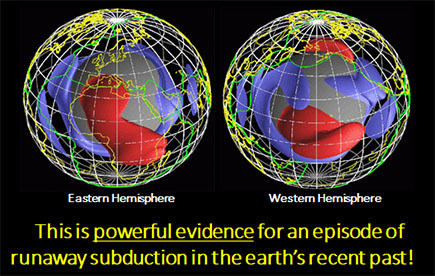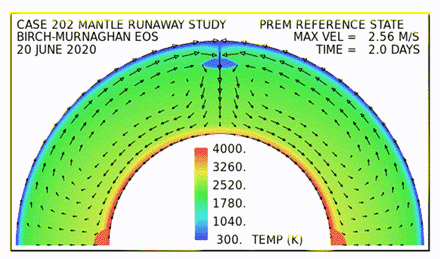Simulating Genesis Flood Cataclysm
Understanding the Physical Processes Responsible for the Genesis Flood Cataclysm
What’s Involved in this Research?

This project views the account of the global Flood cataclysm as described in Genesis 6-8 as actual history of our planet that unfolded only some five thousand years ago in a time span of only a year.
According to this account, all the air-breathing, land-dwelling life forms on earth perished, except for those saved on the ark. The absence of cataclysmic events between Creation and the Flood in the Biblical text argues strongly that all but the topmost portion of the earth’s fossil-bearing sediment record was a result of the Flood cataclysm. The discovery in the 1960’s that all the present-day igneous ocean crust had been generated after much of the continental fossil-bearing sediment record had already been formed has further major implications.

This discovery logically implies that the thousands of miles’ worth of seafloor spreading responsible for today’s igneous ocean crust must also have unfolded during the Flood cataclysm.
The implication is that the Genesis Flood, in addition to involving heavy sustained rainfall and global inundation of the earth, also included rapid and large-scale plate motions that produced thousands of miles of continental displacement.
This project seeks to apply the latest and most comprehensive observational data about the earth, including seismic studies of its interior and experimental data about how its minerals deform under stress, a state-of-the-art understanding of relevant physics processes, combined with state-of-the-art numerical modeling techniques in an earnest effort to understand and model the key physical processes responsible for the cataclysm.
Already it is clear that the well-established experimental finding that earth minerals weaken dramatically under stress must have played a key role in the cataclysm. Numerical simulation of this phenomenon demonstrates that this weakening behavior implies a latent instability exists within the earth. If suitable conditions arise, this instability leads to rapid plate motions and a complete resurfacing of the planet within only a few weeks’ time. Other numerical studies demonstrate that large tsunamis generated by rapid plate motions account for key aspects of the earth’s fossil-bearing sediment record.
Opportunities abound for applying these same methods to a multitude of other issues as to how the Flood so radically transformed the face of the earth not so long ago.
How Students Benefit
A student involved in this research benefits first by acquiring a significant depth and breadth of basic science knowledge, especially in physics. Our program also emphasizes expertise in computational modeling and numerical techniques to equip the student to represent the physical world and the physical laws that govern it accurately in terms of mathematics and then to apply this expertise to obtain robust quantitative descriptions of the way the real world operates.
Expertise in computational geophysics is earnestly sought after in a wide diversity of technical fields today.
Undergraduate students are applying a state-of-the-art computational package (called ABAQUS) to explore the detailed behavior of converging tectonic plates as they lock and unlock and generate large tsunamis under the high plate velocity conditions that operated during the Flood. Fellow Liberty University Research Professor Dr. Cho is expecting soon to have two graduate students investigating state-of-the-art material science issues in silicate minerals. The issues will relate to the experimentally observed weakening behavior that occurs under levels of shear stress that can exist in the earth’s mantle.
Research Professors

Dr. John Baumgardner
B.S., M.S., Ph.D.
Research Professor Emeritus
Google Scholar Profile

Dr. Heechen E. Cho
Ph.D., B.S.
Assistant Professor of Mechanical Engineering
Impact on Society
In my view the future of human civilization depends upon the success of this research endeavor. Certainly, the very survival of the American social and political order is at stake. Over the past 150 years a highly motivated cadre of atheists, many calling themselves humanists, have sought to destroy the authority and influence of the Bible and hence of God and Christianity by challenging the historicity of the Bible’s first eleven chapters. Tragically, this humanist campaign, employing companion ideas of biological evolution and deep time, has largely succeeded, to the extent that most educated people in the world today view the Bible as little more than myth. The 20th century provided two major social experiments to test the humanist illusion that stable social order could be built upon an explicit and overt rejection of God. Both German Nazism and Russian Communism resulted in horrendous suffering and calamity. Take away God and the moral standards He guarantees and one is left only with the law of the jungle—that might makes right.
On the other hand, objective evidence for God reality has never been clearer that it is today in the 21st century, especially given the discoveries in the realm of molecular biology over the past 65 years. Moreover, evidence for the truthfulness of the Bible’s first eleven chapters has also increased dramatically in recent decades. Physical evidence for the global Flood of Genesis 6-8 is now close to overwhelming in its abundance and clarity. It is long past due that Christians went on the offensive against the deceptions of the humanists and restored the Bible to its proper position of authority, historically accurate and true, as God’s very word. The survival of our nation, in my view, urgently depends on it. An objective of this research effort is to make a tangible contribution toward this goal.
Articles
- H. E. Cho, Y. Hammi, A. L. Bowman, S. Karato, J. R. Baumgardner, M. F. Horstemeyer, “A unified static and dynamic recrystallization Internal State Variable (ISV) constitutive model coupled with grain size evolution for metals and mineral aggregates,” International Journal of Plasticity, 112, pp. 123-157, DOI: 10.1016/j.ijplas.2018.08.009, 2019.
- J. Baumgardner, “Understanding how the Flood sediment record was formed: The role of large tsunamis,” in Proceedings of the Eighth International Conference on Creationism, J. H. Whitmore, ed., pp. 287–305, Pittsburgh, Pennsylvania: Creation Science Fellowship, 2018.
- N. Cho, J. Baumgardner, J.A. Sherburn, and M.F. Horstemeyer, “Numerical investigation of strength-reducing mechanisms of mantle rock during the Genesis Flood,” in Proceedings of the Eighth International Conference on Creationism, J. H. Whitmore, ed., pp. 707–730, Pittsburgh, Pennsylvania: Creation Science Fellowship, 2018.
- J. Baumgardner, “Numerical modeling of the large-scale erosion, sediment transport, and deposition processes of the Genesis Flood,” Answers Research Journal 11:149–170, 2018
- J. A. Sherburn, J. R. Baumgardner, and M. F. Horstemeyer, “New material model reveals inherent tendency in mantle minerals for runaway mantle dynamics,” in Proceedings of the Seventh International Conference on Creationism, M. Horstemeyer, editor, Creation Science Fellowship, Inc., Pittsburgh, PA, 2013.
- J. Baumgardner, “Global tectonics—clarity, not confusion,” Journal of Creation 27(1), 99-106, 2013.
- J. Baumgardner, “Do radioisotope methods yield trustworthy relative ages for the earth’s rocks?” Journal of Creation 26(3), 68-75, 2012.
- J. Baumgardner, “Is plate tectonics occurring today?” Journal of Creation 26(1), 101-105, 2012.
- U. Walzer, R. Hendel, and J. Baumgardner, “Continental growth and thermal convection in the Earth’s mantle,” in High Performance Computing in Science and Engineering ’06, W. Nagel, W. Jäger, and M. Resch, eds., Springer-Verlag, Berlin Heidelberg New York, ISBN 978-3-540-36165-7, 473-497, 2006
- K.-D. Gottschaldt, U. Walzer, R. F. Hendel, D. R. Stegman, J. R. Baumgardner, and H.-B. Muhlhaus, “Stirring in 3-d spherical models of convection in the Earth’s mantle,” Philosophical Magazine, 86, 3175-3204, 2006.
- J. R. Baumgardner, “14C Evidence for a Recent Global Flood and a Young Earth,” in Radioisotopes and the Age of the Earth: Results of a Young-Earth Creationist Research Initiative, Volume II, L. Vardiman, A. Snelling, and E. Chaffin, eds., Institute for Creation Research, Santee, CA, 587-630, 2005.
- U. Walzer, R. Hendel, and J. Baumgardner, “Generation of plate-tectonic behavior and a new viscosity profile of the Earth’s mantle,” in NIC Symposium 2004 Proceedings, D. Wolf, G. Münster, and M. Kremer (eds.), NIC Series 20, 419-428., ISBN 3-00-012372-5, 2003.
- J. R. Baumgardner, “Catastrophic plate tectonics: the physics behind the Genesis Flood,” in Proceedings of the Fifth International Conference on Creationism, R. L. Ivey, Jr., Editor, Creation Science Fellowship, Pittsburgh, PA, 113-126, 2003.
- D. R. Humphreys, S. A. Austin, J. R. Baumgardner, and A. A Snelling, “Helium diffusion rates support accelerated nuclear decay,” in Proceedings of the Fifth International Conference on Creationism, R. L. Ivey, Jr., editor, Creation Science Fellowship, Pittsburgh, PA, 175-196, 2003.
- L. Vardiman, S. A. Austin, J. R. Baumgardner, E. F. Chafin, D. B. DeYoung, D. R. Humphreys and A. A Snelling, “Radioisotopes and the age of the Earth,” in Proceedings of the Fifth International Conference on Creationism, R. L. Ivey, Jr., editor, Creation Science Fellowship, Pittsburgh, PA, 337-348, 2003.
- M. F. Horstemeyer and J. R. Baumgardner, “What initiated the Flood cataclysm?” in Proceedings of the Fifth International Conference on Creationism, R. L. Ivey, Jr., editor, Creation Science Fellowship, Pittsburgh, PA, 155-164, 2003.
- J. R. Baumgardner, “Catastrophic plate tectonics: the geophysical context of the Genesis Flood,” “Dealing carefully with the data,” and “A constructive quest for truth,” all contributions to a “Forum on Catastrophic Plate Tectonics,” Ex Nihilo Technical Journal, 16, 57-85, 2002.
- H.-P. Bunge, M. A. Richards, and J. R. Baumgardner, “Mantle-circulation models with sequential data assimilation: inferring present-day mantle structure from plate-motion histories,” Phil. Trans. R. Soc. Lond. A., 360, 2545-2567, 2002.
- D. R. Stegman, M.A. Richards, and J.R. Baumgardner, Effects of depth dependent viscosity and plate motions on maintaining a relatively uniform MORB reservoir in whole mantle flow, J. Geophys. Res., 107, (B6), 2116, doi:10.1029/2001JB000192, 2002.
- M. A. Richards, W.-S. Yang, and J. R. Baumgardner, “The role of a low viscosity zone in stabilizing plate tectonics: implications for comparative terrestrial planetology,” Geochem., Geophys., Geosys., 2, 2001.
- W.-S. Yang and J. R. Baumgardner, “Matrix-dependent transfer multigrid method for strongly variable viscosity infinite Prandtl number thermal convection,” Geophys. and Astrophys. Fluid Dyn., 92, 151-195, 2000.
- M. A. Richards, H.-P. Bunge, C. Lithgow-Bertelloni, and J. R. Baumgardner, “Mantle convection and plate motion history: Toward general circulation models,” History and Dynamics of Global Plate Motions, AGU Monograph Series, 1999.
- M. A. Richards, H.-P. Bunge, Y. Ricard, and J. R. Baumgardner, “Polar wandering in mantle convection models,” Geophys. Res. Lett., 26, 1777-1780, 1999.
- H.-P. Bunge, M. A. Richards, C. Lithgow-Bertelloni, J. R. Baumgardner, S. P. Grand, and B. A. Romanowicz, “Time scales and heterogeneity structure in geodynamic earth models,” Science, 280, 91-95, 1998.
- Hans-Peter Bunge, Mark A. Richards, and John R. Baumgardner, “A sensitivity study of 3-D spherical mantle convection at 108 Rayleigh number: effects of depth-dependent viscosity, heating mode, and an endothermic phase change,” J. Geophys. Res.,102, B6, 11991-12007, 1997.
- C. Burr, “The geophysics of God: A scientist embraces plate tectonics—and Noah’s Flood,” U.S. News & World Report, 55-58, June 16, 1997. (the scientist is John Baumgardner)
- Hans-Peter Bunge, Mark A. Richards, and John R. Baumgardner, “The effect of depth-dependent viscosity on the planform of mantle convection,” Nature, 379, 436-438, 1996.
- Hans-Peter Bunge and John R. Baumgardner, “Mantle convection modeling on parallel virtual machines,” Computers in Physics, 9, 207-215, 1995.
- S. A. Austin, J. R. Baumgardner, D. R. Humphreys, A. A. Snelling, L. Vardiman, and K. P. Wise, “Catastrophic Plate Tectonics: A Global Flood Model of Earth History,” Proceedings of the Third International Conference on Creationism, Technical Symposium Sessions, R. E. Walsh, ed., Creation Science Fellowship, Inc., Pittsburgh, PA, 609-621, 1994.
- J. R. Baumgardner, “Computer Modeling of the Large-Scale Tectonics Associated with the Genesis Flood,” Proceedings of the Third International Conference on Creationism, Technical Symposium Sessions, R. E. Walsh, ed., Creation Science Fellowship, Inc., Pittsburgh, PA, 49-62, 1994.
- J. R. Baumgardner, “Runaway Subduction as the Driving Mechanism for the Genesis Flood,” Proceedings of the Third International Conference on Creationism, Technical Symposium Sessions, R. E. Walsh, ed., Creation Science Fellowship, Inc., Pittsburgh, PA, 63-75, 1994.
- J. R. Baumgardner, “3-D numerical investigation of the mantle dynamics associated with the breakup of Pangea,” in Flow and Creep in the Solar System: Observations, Modeling, and Theory, D. B. Stone and S. K. Runcorn, eds., NATO ASI Series C, Vol. 391, 207-224, 1993.
- J. R. Baumgardner, “3-D finite element simulation of the global tectonic changes accompanying Noah’s Flood,” Proceedings of the Second International Conference on Creationism, R. E. Walsh & C. L. Brooks, eds., Creation Science Fellowship, Inc., Pittsburgh, PA, 35–44, 1990.
- J. R. Baumgardner, “Application of supercomputers to 3-D mantle convection,” in The Physics of the Planets, S. K. Runcorn, ed., John Wiley and Sons, 199-231, 1988.
- J. R. Baumgardner, “Numerical simulation of the large-scale tectonic changes accompanying the Flood,” Proceedings of the First International Conference on Creationism, R. E. Walsh, C. L. Brooks, & R. S. Crowell, eds., Creation Science Fellowship, Inc., Pittsburgh, PA, 17–28, 1986.
- J. R. Baumgardner, “Three-dimensional treatment of convective flow in the earth’s mantle,” J. Stat. Phys., 39, 501-511, 1985.
- J. R. Baumgardner and P. O. Frederickson, “Icosahedral discretization of the two-sphere,” SIAM J. Numer. Anal., 22, 1107-1115, 1985.